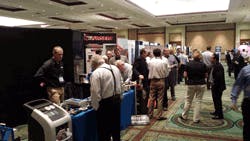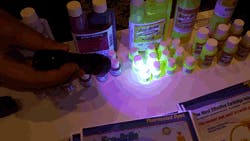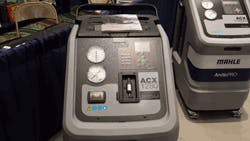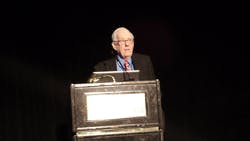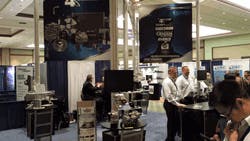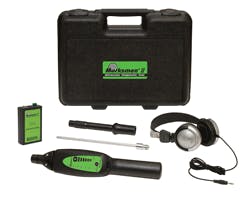Air conditioning service is a something we in the Deep South perform 12 months a year, and sometimes I have to stop and remind myself that the 80°F February day I’m experiencing is not representative of the weather my Northern brethren experience. I’m sure it’s hard for them to even consider A/C work while they are digging out from several feet of snow. But the annual Mobile Air Conditioning Society (MACS) convention, hosted every February in a generally warm location, gives us all a chance to take a break from the season’s challenges and prepare for the time our customers begin complaining about the heat, rather than the cold.
Like This Article?
Check out related training at
The MACS trade show and training event allows an attendee to see the latest and greatest in A/C and cooling system products and services, as well as sharpen business and technical skills through the training offered and an annual look at the state of the A/C industry.
Snapshots in Time
While not directly tied to A/C repair, Marty Miller of Experian Automotive presented an interesting collection of data on the light truck/passenger car market to attendees. For example, you hear a lot about the average age of cars on the road in the United States, but did you know that factors offset that statistic’s value, impacting the number? More important to understand, whether you are in marketing or just own your own shop, are the Vehicles In Operation (VIO) statistics.
VIOs are “a snapshot in time,” according to Miller, the number of vehicles on the road at any given time. Twelve months ago, the U.S. VIO was approximately 245 million, and today it is roughly 251 million. On the surface, it looks like little change, but diving into the factors that make up the number, a different picture is seen. The VIO is made upof existing vehicles plus new car sales, less cars removed from service (scrapped or exported). During the last 12 months, 10.2 million cars were removed from the VIO and 16 million new cars were sold (up from the previous 12 months and almost double the number of new cars sold at the peak of the recession a few years back). Within the VIO, though, are the used car sales, which accounted for a 38 million car change in the make up of the total VIO.
And to get an overall feel for the market’s opportunities, it’s more important to consider what Miller calls the “aftermarket sweet spot.” These are the cars that are 6 to 12 years old and historically, the ones whose owners are investing in more substantial repairs and maintenance. In the U.S., there currently are 93 million cars and light trucks in the sweet spot, a number that has been on a slight decline during the last few years.
Some other interesting factoids Miller shared are:• Domestic makes still hold the majority of the light truck market, but the imports dominate the passenger car market and their lead is growing.
• Full size pickups lead the VIO with a 15 percent share, while hybrids make up only a 1.3 percent share.
• The Ford F150 is the leader in light trucks, but there actually are more GM-made trucks overall when you factor in the GMC and Chevy brands together.
• Six cylinder powerplants are on the decline, 4 cylinders are on the rise and interestingly enough, vehicles with 8 cylinder engines have remained steady during the last several years.
• The big three in America today are Ford, GM and Toyota, with FCA (Chrysler) a close fourth.
Now, I’ve been using dye for years to locate leaks in a variety of systems, not just A/C, and as I wandered the exhibits, I saw the usual collection of dye makers displaying their wares. As I passed the Brighter Solutions booth, though, I noticed that three small lights, all apparently the same at first, on the table and I had to stop and take a closer look. I learned that the lights were, indeed, different. The light wavelengths were the distinguishing feature and I discovered that, for optimum fluorescence, the light should
be matched to the dye. One specifically designed for A/C use caused the mated dye to glow as if it had an inner light, while the same dye illuminated by the lamp with the lowest wavelength only caused the dye to glow dimly in the same light. It, however, was more effective when mated with dye additives used for engine oil or transmission fluid leaks. All these years in the business and I thought it was a one size fits all deal!
Stopping by the Tracer Products booth a bit later, I confirmed what I had just learned from their product specialists. But on display was a tool I had some familiarity with but never had seen offered by this particular company. It was an ultrasonic leak detection kit; similar in concept to the Steelman Tools product I produced an episode of The Trainer on in August 2014. The Tracer Products reps at the booth and I talked about the variety of uses such a tool could be applied to, including looking for A/C leaks, simply by liste
Also on display were new Recovery, Recycle and Recharge (RRR) machines, including the new ACX-series of machines from MAHLE Aftermarket. The two models on display included one dedicated to servicing the new refrigerant, R1234yf, and the differences between the two were noteworthy. Due to the nature of R1234yf, the specifications for the machine include ventilation of the cabinet to prevent any build-up of refrigerant that might occur should there be a small leak internally and a built-in refrigerant identifier to prevent the machine (and its charge of very expensive gas) to become contaminated.
With the EPA proposing a phase down of R134a (in new vehicles by the 2021 model year), it’s only a matter of time before shops will need to add these new machines to their inventory. The question now that shop owners have to answer is when that time happens for them individually. I know there still are questions on the future of refrigerants in the United States and the answers we seek we on Saturday, when Ward Atkinson delivered his “State of the Industry” presentation.
State of the A/C Industry
Formal training sessions were on hold Friday so that everyone could have the opportunity to walk the trade show. This also allowed the trainers, such as John Thornton, Standard Motor Products’ Ryan Kooiman and Dephi’s Dave Hobbs, who held classes on Thursday to take a break and prepare for their Saturday sessions. Even though the MACS event focuses on the mobile air conditioning and heating sector, their training offerings are well-rounded, meeting the needs of their members in both the light duty and heavy duty markets. Classes covered reprogramming and diagnosing network communications problems in addition to several offered on core topics like diagnosing variable displacement compressors and system airflow issues.
For many, though, the star attraction every year the presentation Ward Atkinson, former chair of the SAE Interior Climate Control Committee, makes. This year’s presentation started with highlights on the EPA’s proposed rule to phase down the use of R134a in the United States. If you haven’t heard that yet, and were around long enough to remember the phase out of R12 and the headaches that resulted, let me set some things straight for you right away.
First, this is a phase down, meaning that during the next several years we will see R134a being replaced as the refrigerant of choice in new model cars with the goal of full transition by model year 2021. Unlike the R12 days, there is no plan to retrofit current R134a cars to a replacement gas, and Atkinson assured his listeners that there would be plenty of R134a around to continue servicing these systems for many years to come.
“From prior MACS surveys and other data, less than 10 percent of the R12 fleet was ever retrofitted,” Atkinson said. “Believe me, you will not retrofit the R134a cars with the new refrigerants. And that’s why we are extremely happy with EPA’s decision (to continue to allow R134a to service existing systems).”
You may remember that this all started with a ruling in the European Union requiring new vehicle platforms to use a refrigerant with a Global Warming Potential (GWP) rating less than 150. That spelled the end of R134a, and the selection of a suitable replacement is still a matter of debate, with R1234yf the favored choice for now. Here in the United States, there is no such magic number, and any refrigerant on the approved list is a potential candidate as a R134a replacement. R1234yf certainly is at the top of that list, but other potential refrigerants we might see in use include R744 (carbon dioxide), R445a (a blend refrigerant containing 6 percent R744, 9 percent R134a and 85 percent R1234ze) and R152a (a flammable gas we thought had been taken off the table years ago).
Atkinson also cautioned attendees to be aware of imported R134a that does not meet the SAE purity standards, J2776. Refrigerant suppliers that do will have that stamped on both the container and the shipping container and sticking to these suppliers will ensure the quality of the gas you’re installing in your customer’s car. While the imported refrigerant is cheaper, it might contain contaminants you’re refrigerant identifier won’t pick up.
Another topic of concern he shared was that of an advertised “environmentally friendly” alternative to R134a that had recently appeared in the market. Atkinson told the crowd, “Let’s not be fooled folks. You go get an MSDS (Material Safety Data Sheet) on it and it doesn’t tell you what it is, but it’s similar to the stuff you use in your barbeque (grill).”
He further explained that this is a hydrocarbon refrigerant (meaning it is highly flammable) and automotive systems are not designed to use it. “If you decide to install these (refrigerants) into your customers’ cars, you could be setting yourself up for a big liability issue.”
It also makes the case for adding a refrigerant identifier to your shop if you don’t already own one. You never know if the car you’re working on has been contaminated by a DIYer or another shop!
Atkinson then talked about service concerns facing the industry as new technologies and system strategies were being introduced. For example, many newer cars automatically enter “recirculation” mode when the ambient temperature goes higher than 75°F. How many control units do you think will be replaced in attempts by untrained technicians who think this is a fault and not a design feature?
“Basically we have lots of bells and whistles on these new cars that are going to be doing all kinds of things,” commented Atkinson, adding that recommendations were made encouraging the SAE committee to consider standards for the proper diagnosis and repair of these systems.
And with those new standards and technologies will come a need for additional training.


